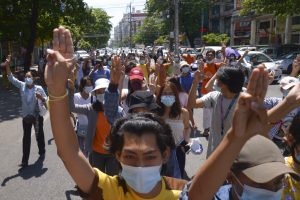Myanmar’s shadow National Unity Government (NUG) announced yesterday that it had formed a “people’s defense force” to protect its supporters from attacks and consolidate opposition to the military junta that seized power in February.
In a statement, it said the move was a prelude to the establishment of a Federal Union Army and that it had the responsibility to “make effective reforms in the security sector in order to terminate the 70 year long civil war.”
“Today, May 5, we formed the People’s Defense Force. Preparations for this army were made a long time ago. A lot of time has gone into training,” Khin Ma Ma Myo, the NUG’s deputy minister of defense, told Radio Free Asia. She added that a “defense acquisition department” had been established under her shadow ministry.
The PDF will function as the military wing of the NUG, which was established on April 16 by an array of groups opposed to the junta, including the Committee Representing Pyidaungsu Hluttaw, an organization of parliamentarians belonging to the National League for Democracy (NLD), which was ousted from power by the coup.
The NUG’s aim is to compete with the military junta for international recognition with the ultimate aim of restoring democracy, excising the military from Myanmar’s politics, and building a “federal democratic union.” The NUG statement described the PDF a precursor to a Federal Union Army which would seek to come together with Myanmar’s raft of armed ethnic insurgent groups to fight the Tatmadaw to these ends.
The military’s takeover has exacerbated a number of long-running conflicts in Myanmar’s borderlands, pitting ethnic minority groups against the central state. Serious fighting has erupted between the military and ethnic rebels in Karen and Kachin States, which have been followed by air strikes that have driven thousands of people to flee their homes, including across the border into Thailand. Earlier this week, during one such air raid, the Kachin Independence Organization (KIO) announced that its armed wing had shot down a Myanmar military helicopter.
Some ethnic armed groups, including the Karen National Union (KNU), have also granted sanctuary and military training to activists who have fled Myanmar’s central regions due to military crackdowns. Meanwhile, in other parts of Myanmar, the military’s deadly crackdowns on anti-coup protesters have also prompted the creation of citizens’ militias that have carried out deadly attacks on soldiers.
Taken as a whole, these recent developments suggest the existence of an incipient nationwide armed opposition to the military regime led by Sen. Gen. Min Aung Hlaing, which the PDF will now aim to unify.
To be sure, Myanmar’s armed forces, or Tatmadaw, are one of Asia’s best-equipped militaries and dwarf the combined size of the country’s various ethnic armed groups by several times. According to one informed estimate, the military fields around 350,000 troops to 75-000-78,000 for the rebel groups. However, coordinated offensives around the country’s periphery could stretch the military thin, taking place alongside mass urban protests, and play an important supplementary role to political efforts aimed at winning international support away from the junta.
However, there is a long way to go before the PDF succeeds in founding a Federal Union Army or fostering the degree of coordination necessary to threaten the Tatmadaw on the battlefield. The past three months have made clear that the NUG and most of the ethnic armed organizations share a common opposition to the military and its recent coup, but it is less certain how far their positive goals align.
Each organization has its own goals, personalities, and history of relations with the central state. While the KIA and KNU have been actively supportive of the NUG and the anti-coup movement, others, like the Restoration Council of Shan State, have been rhetorically supportive without taking significant actions. Still others, most notably the Arakan Army in western Myanmar, continue to harbor a mistrust of the NUG and the former NLD government.
Uniting these various groups into something approaching a common front will therefore involve a protracted process of negotiation.
The announcement by the NUG came as more than 200 global organizations urged the U.N. Security Council on Wednesday to impose an arms embargo on Myanmar.
Arguing that the military junta has demonstrated “a callous disregard for human life” since its takeover, killing at least 769 people, including children and other bystanders, the NGOs stated that “no government should sell a single bullet to the junta under these circumstances.”
It added, “Imposing a global arms embargo on Myanmar is the minimum necessary step the Security Council should take in response to the military’s escalating violence.”

































